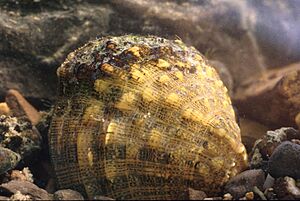Fanshell facts for kids
Quick facts for kids Fanshell |
|
|---|---|
 |
|
| Conservation status | |
| Scientific classification | |
| Genus: |
Cyprogenia
|
| Species: |
stegaria
|
| Synonyms | |
|
List
Cyprogenia irrorata (Lea, 1828)
Cyprogenia irrorata irrorata (Lea, 1828) Cyprogenia irrorata pusilla Simpson, 1900 Obovaria stegaria Rafinesque, 1820 Unio irroratus Lea, 1828 Obovaria stegaria tuberculata Rafinesque, 1820 Obovaria stegaria fasciolata Rafinesque, 1820 Unio verrucosus albus Hildreth, 1828 |
|
The fanshell (Cyprogenia stegaria) is a type of clam that lives in water. It is a bivalve mollusk, which means it has two shells that hinge together, like many clams and mussels. This special clam is found only in the United States.
Sadly, the fanshell is an endangered species. This means there are very few of them left in the wild. They are protected by law in the United States because their numbers are so low.
You can find fanshells reproducing in only a few rivers. These include the Clinch River in Tennessee and Virginia. They also live in the Green and Licking Rivers in Kentucky. There might be a small group in the Tennessee River too. Some other small groups of fanshells might exist, but they are not reproducing.
Why Fanshells Are in Danger
The main reason fanshells are endangered is because their homes are being lost or damaged. This is called habitat loss and degradation. When rivers become polluted or changed, it makes it hard for these clams to survive and reproduce.
Fanshell Life Cycle
All mussels in the Unionidae family, like the fanshell, have a very interesting way of reproducing. Their babies, called glochidia, need a fish to grow up. The glochidia attach to the gills, fins, or skin of a host fish. They get nutrients from the fish during this early stage.
The fanshell has a clever trick to get its babies onto a fish. It releases a special package into the water. This package is called a conglutinate. It looks just like a small worm, like an Oligochaeta worm. Inside this "worm" are the tiny mussel babies.
When a fish sees the conglutinate, it thinks it's a tasty worm and bites it. As the fish bites, the conglutinate breaks open. This releases the young glochidia. The glochidia then quickly attach themselves to the fish's gills. They stay there for a while, growing bigger and stronger. Once they are developed enough, they drop off the fish and start their lives as young fanshells on the riverbed.



